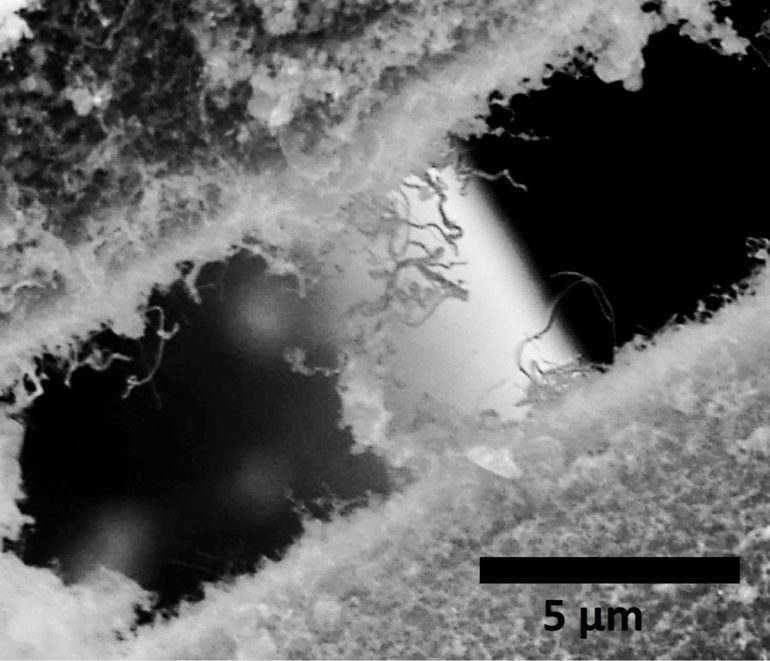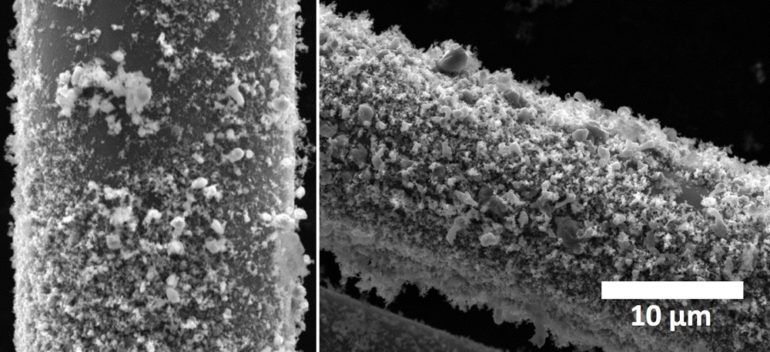Notes Of A Dead Man Sequel (Notes - #3) by Clive Cooper (best contemporary novels .TXT) 📖

- Author: Clive Cooper
Book online «Notes Of A Dead Man Sequel (Notes - #3) by Clive Cooper (best contemporary novels .TXT) 📖». Author Clive Cooper
The Smithsonian Tropical Research Institute, the Fulbright Scholar Program, and the National Science Foundation funded the work.
Source: Eric Bender for Boston University
Like likeShe likes me or she doesn't likes me!?
Fuzzy fibers for rocket engines can take the heatby Mike Williams-Rice

To stand up to the heat and pressure of next-generation rocket engines, the composite fibers used to make them should be fuzzy, say researchers.
Their “fuzzy fibers” of silicon carbide act like Velcro and stand up to the punishment that materials experience in aerospace applications.
The fibers strengthen composites used in advanced rocket engines that have to withstand temperatures up to 1,600 degrees Celsius (2,912 degrees Fahrenheit). Ceramic composites in rockets now being developed use silicon carbide fibers to strengthen the material, but they can crack or become brittle when exposed to oxygen.
 Silicon carbide nanotubes attached to separate silicon carbide fibers, used by NASA, entangle each other in this electron microscope image. (Credit: Ajayan Research Group/Rice)
Silicon carbide nanotubes attached to separate silicon carbide fibers, used by NASA, entangle each other in this electron microscope image. (Credit: Ajayan Research Group/Rice) Researchers burned away carbon nanotubes grown on the silicon carbide fiber at left with a lighter. At right, the same fiber shows the nanotubes have been burned away. (Credit: Ajayan Research Group/Rice)
Researchers burned away carbon nanotubes grown on the silicon carbide fiber at left with a lighter. At right, the same fiber shows the nanotubes have been burned away. (Credit: Ajayan Research Group/Rice)
The laboratory of Rice University materials scientist Pulickel Ajayan embedded silicon carbide nanotubes and nanowires into the surface of NASA’s fibers. The exposed parts of the fibers are curly and act like the hooks and loops that make Velcro so valuable—but on the nanoscale.
The result, according to lead researchers Amelia Hart, a graduate student, and Chandra Sekhar Tiwary, a postdoctoral associate, creates very strong interlocking connections where the fibers tangle; this not only makes the composite less prone to cracking but also seals it to prevent oxygen from changing the fiber’s chemical composition.
Hart and her colleagues grew their hooks and loops by first bathing silicon carbide fiber in an iron catalyst and then using water-assisted chemical vapor deposition, a process developed in part at Rice, to embed a carpet of carbon nanotubes directly into the surface. These become the template for the final product. The fibers were then heated in silicon nanopowder at high temperature, which converts the carbon nanotubes to silicon carbide “fuzz.”
The researchers hope their fuzzy fibers will upgrade the strong, light, and heat-resistant silicon carbide fibers that, when put in ceramic composites, are being tested for robust nozzles and other parts in rocket engines. “The silicon carbide fiber they already use is stable to 1,600 C,” Tiwary says. “So we’re confident that attaching silicon carbide nanotubes and wires to add strength will make it even more cutting-edge.”
How to turn astronaut poop into rocket fuel
The new materials should also make entire turbo engines significantly lighter, Hart says. “Before they used silicon carbide composites, many engine parts were made of nickel superalloys that had to incorporate a cooling system, which added weight to the whole thing,” she says. “By switching to ceramic matrix composites, they could take out the cooling system and go to higher temperatures. Our material will allow the creation of larger, longer-lasting turbo jet engines that go to higher temperatures than ever before.”
Friction and compression testing showed the lateral force needed to move silicon carbide nanotubes and wires over each other was much greater than that needed to slide past either plain nanotubes or unenhanced fibers, the researchers report. They were also able to easily bounce back from high compression applied with a nano-indenter, which showed their ability to resist breaking down for longer amounts of time.
Tests to see how well the fibers handled heat showed plain carbon nanotubes burning away from the fibers, but the silicon carbide nanotubes easily resisted temperatures of up to 1,000 C (1832 F).
Hart says the next step will be to apply her conversion techniques to other carbon nanomaterials to create unique three-dimensional materials for additional applications.
The work appears in Applied Materials and Interfaces. Additional coauthors are from Rice; Hysitron Inc. in Minneapolis, part of Bruker Corp.; and NASA Glenn Research Center.
The NASA Jenkins Fellowship and the Air Force Office of Scientific Research through its 3D Multidisciplinary University Research Initiative grant supported the research.
Source: Rice University
Mice have invaded our homes since before farmingby Gerry Everding-WUSTL
Hunter-gatherers began putting down roots in the Middle East long before the advent of agriculture. Their creation of more permanent homes altered the ecological balance in ways that allowed the common house mouse to flourish, research shows.
“The research provides the first evidence that, as early as 15,000 years ago, humans were living in one place long enough to impact local animal communities—resulting in the dominant presence of house mice,” says Fiona Marshall, professor of anthropology at Washington University in St. Louis. “It’s clear that the permanent occupation of these settlements had far-reaching consequences for local ecologies, animal domestication, and human societies.”
The research is exciting because it shows that settled hunter-gatherers—not farmers—were the first people to transform environmental relations with small mammals, says Marshall.
By providing stable access to human shelter and food, hunter-gatherers led house mice down the path to commensalism—an early phase of domestication in which a species learns how to benefit from human interaction.
The findings have broad implications for the processes that led to animal domestication.

A mouse from a Maasai village in southern Kenya. (Credit: Lior Weissbrod)House mouse and country mouse
The study set out to explain large swings in the ratio of house mice to wild mice populations found during excavations of different prehistoric periods at an ancient Natufian hunter-gatherer site in the Jordan Valley of Israel.
Examining tiny species-related variations in the molar shapes of fossilized mice teeth dating back as far as 200,000 years, the team built a timeline showing how the populations of different mice fluctuated at the Natufian site during periods of varying human mobility.
The analysis revealed that human mobility influenced competitive relationships between two species of mice—the house mouse (Mus musculus domesticus) and a short-tailed field mouse (M. macedonicus)—that continue to live in and around modern settlements in Israel.
These relationships are analogous to those of another pair of species called spiny mice which researchers discovered among semi-nomadic Maasai herders in southern Kenya.
Scientists ‘replay’ evolution with mouse teeth
The findings indicate that house mice began embedding themselves in the Jordan Valley homes of Natufian hunter-gatherers about 15,000 years ago, and that their populations rose and fell based on how often these communities picked up and moved to new locations.
When humans stayed in the same places for long runs of time, house mice out-competed their country cousins to the point of pushing most of them outside the settlement. In periods when drought, food shortages, or other conditions forced hunter-gatherers to relocate more often, the populations of house mice and field mice reached a balance similar to that found among modern Maasai herders with similar mobility patterns.
Published in the Proceedings of the National Academy of Sciences, the study confirms that house mice were already a fixture in the domiciles of eastern Mediterranean hunter-gatherer villages more than 3,000 years before the earliest known evidence for sedentary agriculture.
It suggests that the early hunter-gatherer settlements transformed ecological interactions and food webs, allowing house mice that benefited from human settlements to out-compete wild mice and establish themselves as the dominant population.
“The competition between commensal house mice and other wild mice continued to fluctuate as humans became more mobile in arid periods and more sedentary at other times—indicating the sensitivity of local environments to degrees of human mobility and the complexity of human environmental relationships going back in the Pleistocene,” says Lior Weissbrod, a research fellow at the Zinman Institute of Archaeology at the University of Haifa in Israel.

Mice teeth used in the study were recovered during excavations at the prehistoric Natufian settlement site of Eyna (also known as Ain Mallaha) in the Jordan Valley north of Jerusalem. (Credit: Base map generated by Lior Weissbrod from Environmental Systems Research Institute (ESRI) data using ArcGIS v.9.1.)Mice teeth
Thomas Cucchi of National Center for Scientific Research in Paris used a new technique called geometric morphometrics to identify the mouse fossils and reliably distinguish telltale differences in the miniscule remains of house mice and wild species. The method relies on high resolution imaging and digital analysis to categorize species-related variations in molar outlines nearly as thin as a single millimeter.
The findings, and the techniques used to document them, are important to archaeological research in a broader sense because they lend further support to the idea that fluctuations in ancient mouse populations can be used as a proxy for tracking ancient shifts in human mobility, lifestyle and food domestication.
“These findings suggest that hunter-gatherers of the Natufian culture, rather than later Neolithic farmers, were the first to adopt a sedentary way of life and unintentionally initiated a new type of ecological interaction—close coexistence with commensal species such as the house mouse,” Weissbrod says.
“The human dynamic of shifts between mobile and sedentary existence was unraveled in unprecedented detail in the record of fluctuations in proportions of the two species through time.”
Source: Washington University in St. Louis





Comments (0)